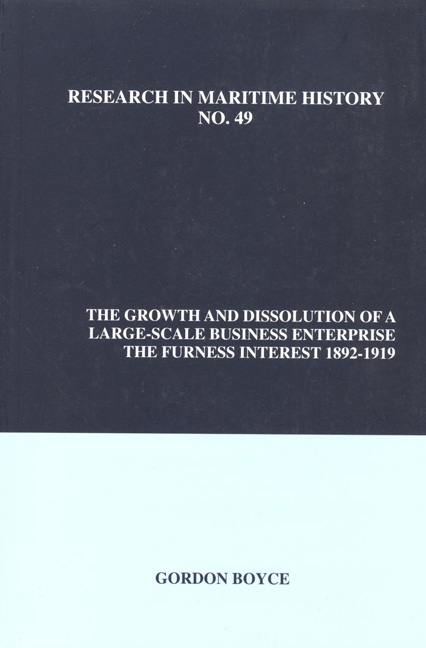Book contents
- Frontmatter
- Table of Contents
- About the Author
- Acknowledgements
- Figures and Tables
- Introduction
- Chapter 1 Furness' Shipping Services: Growth by Organic Means in the 1880s
- Chapter 2 The 1890s: Furness Withy's Expansion by Acquisition and Promotion
- Chapter 3 Diversification into the Industrial Sector, 1895-1901
- Chapter 4 Trouble on the Transatlantic Route: The Formation of the IMM and Furness' Response
- Chapter 5 The Growth of Shipping Services, 1902-1909
- Chapter 6 Industrial Operations and Performance, 1900-1914
- Chapter 7 The Growth of the Shipping Interests, 1910-1919
- Chapter 8 Structure
- Chapter 9 Finance
- Chapter 10 Holding Company Investment Activities and Intermediary Operations
- Chapter 11 Personnel
- Chapter 12 Furness
- Chapter 13 Dissolution
- Appendix 1 Development of the Combined Fleet, 1900-1919
- Appendix 2a Patterns of Ownership: The Furness Group, 1919
- Appendix 2b Reorganization of Branch Offices and Superintending Departments, 1911-1912
- Appendix 3a Fluctuations in Freights, Profits, Tonnage Afloat and Merchant Shipping Output
- Appendix 3b Output of Merchant Tonnage (Excluding Warships), 1892-1913
- Appendix 3c Fluctuations in the Price of a 7500-ton Cargo Steamer, 1898-1913
- Appendix 4 Development of the Furness Group: Principal Promotions, Acquisitions and Divestments, 1880-1919
- Appendix 5 Northern Allies and Maritime Associates
- Appendix 6 Contemporary Accounting Law and Conventions, 1845-1914
- Appendix 7 Lord Furness' Movements, 1899-1912
- Bibliography
Chapter 8 - Structure
- Frontmatter
- Table of Contents
- About the Author
- Acknowledgements
- Figures and Tables
- Introduction
- Chapter 1 Furness' Shipping Services: Growth by Organic Means in the 1880s
- Chapter 2 The 1890s: Furness Withy's Expansion by Acquisition and Promotion
- Chapter 3 Diversification into the Industrial Sector, 1895-1901
- Chapter 4 Trouble on the Transatlantic Route: The Formation of the IMM and Furness' Response
- Chapter 5 The Growth of Shipping Services, 1902-1909
- Chapter 6 Industrial Operations and Performance, 1900-1914
- Chapter 7 The Growth of the Shipping Interests, 1910-1919
- Chapter 8 Structure
- Chapter 9 Finance
- Chapter 10 Holding Company Investment Activities and Intermediary Operations
- Chapter 11 Personnel
- Chapter 12 Furness
- Chapter 13 Dissolution
- Appendix 1 Development of the Combined Fleet, 1900-1919
- Appendix 2a Patterns of Ownership: The Furness Group, 1919
- Appendix 2b Reorganization of Branch Offices and Superintending Departments, 1911-1912
- Appendix 3a Fluctuations in Freights, Profits, Tonnage Afloat and Merchant Shipping Output
- Appendix 3b Output of Merchant Tonnage (Excluding Warships), 1892-1913
- Appendix 3c Fluctuations in the Price of a 7500-ton Cargo Steamer, 1898-1913
- Appendix 4 Development of the Furness Group: Principal Promotions, Acquisitions and Divestments, 1880-1919
- Appendix 5 Northern Allies and Maritime Associates
- Appendix 6 Contemporary Accounting Law and Conventions, 1845-1914
- Appendix 7 Lord Furness' Movements, 1899-1912
- Bibliography
Summary
In Britain and America, large-scale enterprise arose in response to different formative influences of unequal strength. As a result, the kinds of administrative problems firms encountered due to their patterns of growth and the structural forms that officials employed to monitor and control increasingly complex corporate activities also varied. In his pioneering work, Alfred Chandler emphasized the importance of variations in legal prescriptions, production technology and the size and character of the market in shaping growth trajectories, the capabilities of emerging large-scale enterprise and the administrative structures they used to harness core product/process-related skills. In his investigation of the growth of large companies in America during the 1880s and 1890s, Chandler identified two general patterns of expansion: vertical integration and horizontal combination.
In America during the 1880s, the rise of a mass urban market exposed new opportunities to which companies that marketed perishable products, employed methods of continuous production or manufactured standardized machinery responded by establishing their own marketing organizations and integrating them with manufacturing operations. This strategy of vertical integration enabled companies to maintain high levels of output and thereby reduce production costs and increase efficiency. While vertical expansion became the dominant form of growth in the 1880s, a number of large horizontal mergers also came into being during the decade. These combinations sought to control the prices and output of numerous operating units. This alternative strategy developed out of trade associations, and the firms that adopted it generally formed trusts or holding companies.
During the 1890s, horizontal combination superseded vertical expansion as the most frequently employed strategy of growth. There were two surges in horizontal amalgamation. First, between 1890 and 1893, firms combined in the face of public criticism of trade associations and trusts and in direct response to the passage of the Sherman Antitrust Act. In order to adopt a more secure legal position, a number of firms and trusts registered as holding companies under the laws of New Jersey. Second, following the recession of 1893-1897, the strong recovery of the economy, the emergence of a wider market for industrial securities, the clarification of the Sherman Act by the Supreme Court and increasing recognition of oligopolistic interdependence ignited a much larger merger wave that embraced nearly every industry.
- Type
- Chapter
- Information
- The Growth and Dissolution of a Large-Scale Business EnterpriseThe Furness Interest, 1892-1919, pp. 213 - 248Publisher: Liverpool University PressPrint publication year: 2012

